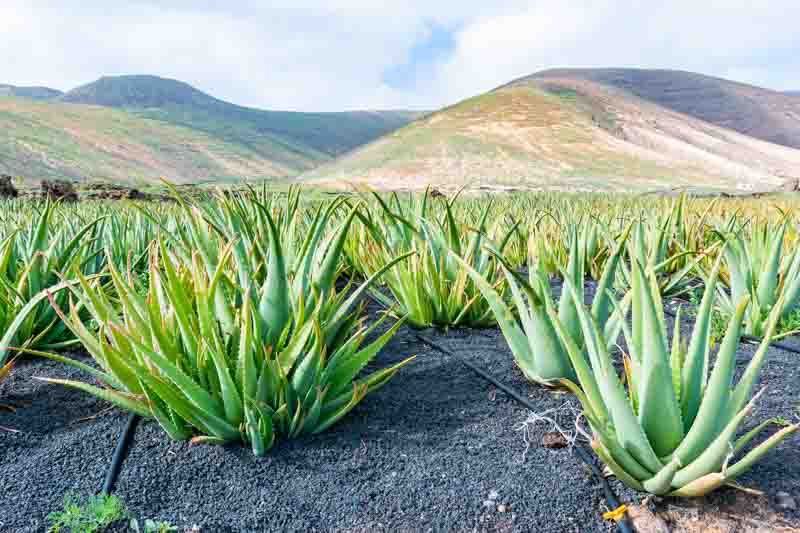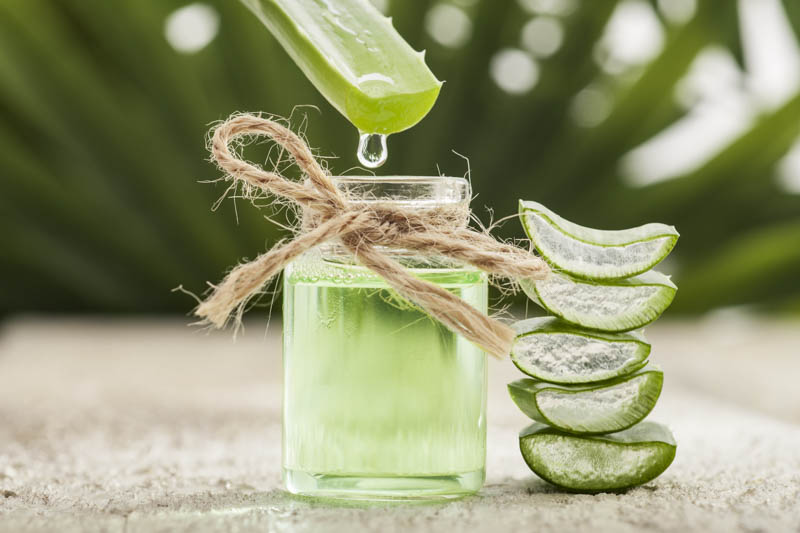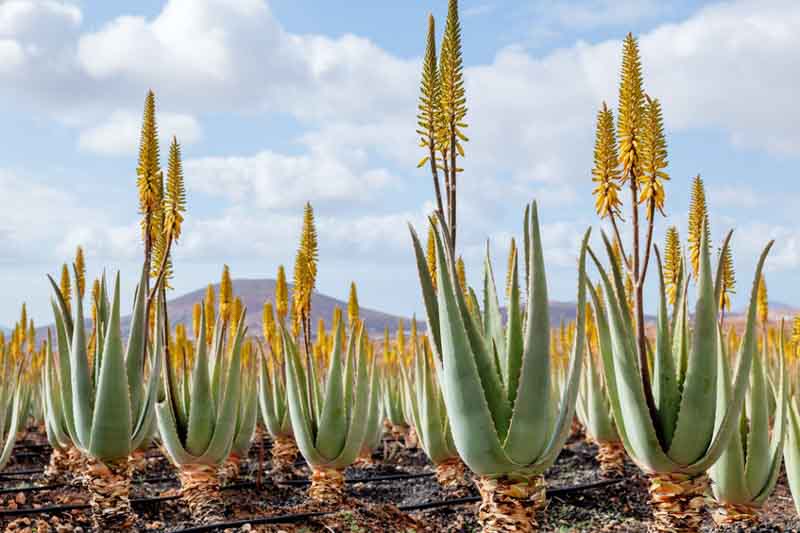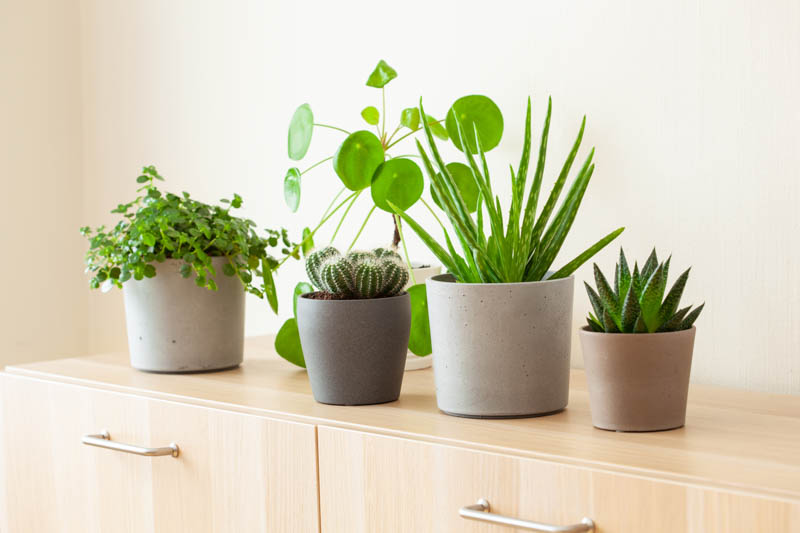Barbados Aloe, Aloe vera, Aloe perfoliata, Aloe barbadensis, Curaçao Aloe, Bitter Aloes, Medicinal Aloe
Aloe vera (Aloe barbadensis) is a perennial, succulent plant native to the Arabian Peninsula, belonging to the Asphodelaceae family. It has been cultivated and used for centuries for its medicinal, cosmetic, and ornamental properties. Aloe vera is well-known for its distinctive fleshy, green leaves that store water and gel, which are the main sources of its therapeutic benefits.
Description: Aloe vera forms a rosette of long, fleshy, narrow green leaves that can be up to 18 inches (45 cm) long. The leaves are green to gray-green in color, with small white teeth along the margins. The leaves turn reddish purple when the plant is under drought stress. In spring and summer, long racemes of tubular greenish-yellow flowers are borne on 3 feet (90 cm) branched inflorescences above the foliage.
Height/Spread: The plant typically grows between 1-2 feet (30-60 cm) tall and 2-3 feet wide (60-90 cm). The plant can grow up to 3 feet (90 cm) in the right conditions.
Hardiness: Aloe vera thrives in USDA zones 10-12. It is not frost-tolerant, so it should be grown as a houseplant or moved indoors during cold weather in cooler climates.
Drought/Salt: Aloe vera is a drought-tolerant plant that can survive in harsh conditions. It can tolerate periods of low water availability and even withstand a certain level of salinity in the soil.
Health Benefits: The plant is rich in vitamins, minerals, enzymes, and amino acids. It has anti-inflammatory, antimicrobial, and antioxidant properties that promote skin health, wound healing, and immune system support.
Medicinal Uses: Aloe vera gel is widely used for its soothing and healing properties. It can be applied topically to treat burns, sunburns, cuts, and skin irritations.
Cosmetic Uses: Aloe vera gel is often used in skincare products, such as creams, lotions, and facial masks, due to its moisturizing, anti-inflammatory, and anti-aging effects.
Oral Health Uses: Aloe vera can be found in some toothpaste and mouthwash products for its antimicrobial and anti-inflammatory properties, promoting oral health.
Ornamental Uses: Aloe vera can be grown as an attractive, low-maintenance houseplant or in a succulent garden.
Award: Aloe vera is the recipient of the prestigious Award of Garden Merit of the Royal Horticultural Society.
Deer: Aloe vera is not a favorite of deer, making it an ideal choice for gardeners dealing with deer browsing.
Toxicity: Aloe vera can be toxic to pets, particularly cats and dogs if ingested. The issue lies in the presence of a compound called saponins, which are found in the outer leaf of the plant. When consumed, saponins can cause symptoms like vomiting, diarrhea, lethargy, tremors, and, in severe cases, kidney issues or electrolyte imbalances.
Aloe Vera is a versatile and beneficial plant, offering numerous health benefits and cosmetic uses. It is an easy-to-grow, low-maintenance plant that can be a beautiful and functional addition to any home or garden.

Growing Aloe vera can be advantageous for various reasons, including its medicinal, cosmetic, and ornamental properties, as well as its low-maintenance nature. Here are some reasons why you should grow this wonderful plant:
Medicinal benefits: Aloe vera gel has soothing and healing properties, making it an excellent natural remedy for treating burns, sunburns, cuts, and skin irritations. Having an Aloe vera plant at home allows you to have a fresh supply of its gel for immediate use.
Cosmetic benefits: Aloe vera gel is widely used in skincare products due to its moisturizing, anti-inflammatory, and anti-aging effects. By growing your own Aloe vera, you can extract the gel for use in homemade skincare treatments, such as face masks and moisturizers.
Air purifying: Aloe vera is known to be an excellent air purifier, helping remove pollutants like formaldehyde and benzene from indoor air. Growing it indoors can improve air quality and create a healthier living environment.
Low-maintenance: Aloe vera is a drought-tolerant, easy-to-grow plant that requires minimal care, making it an ideal choice for busy individuals or those new to gardening.
Ornamental appeal: Aloe vera’s distinctive fleshy leaves and unique growth habit make it an attractive houseplant or addition to a succulent garden. Its tubular, yellow flowers on a tall spike also add visual interest.
Pest-resistant: The plant is generally resistant to most pests and diseases, ensuring a healthy and thriving plant with little effort.
Economic benefits: Growing Aloe vera at home can save you money on purchasing store-bought gel and skincare products, as well as reducing plastic waste associated with packaging.
Educational opportunity: Growing Aloe vera can be an engaging activity for children, teaching them about plant care, natural remedies, and the importance of sustainable living.
By growing Aloe vera, you can enjoy its numerous benefits while adding an attractive, low-maintenance plant to your home or garden.

Making Aloe vera gel at home is simple and straightforward. Follow these steps to obtain and use the gel from your plant:
Choose a healthy leaf: Select a thick, mature leaf from the outer section of the plant. These leaves will contain the most gel.
Cut the leaf: Use a clean, sharp knife or pair of scissors to cut the leaf as close to the base as possible. Be cautious, as the leaves can have sharp edges.
Drain the latex: Hold the cut end of the leaf over a bowl or sink and allow the yellow latex (a substance that can be irritating to the skin) to drain for a few minutes. You can also gently squeeze the leaf to help the process.
Rinse the leaf: To remove any remaining latex, rinse the cut leaf under cold water.
Remove the gel: Place the leaf on a clean cutting board. Cut off the serrated edges and the top green layer of the leaf, exposing the clear gel inside. Use a spoon to carefully scoop out the gel, being cautious not to include any remaining latex. Alternatively, you can fillet the leaf by cutting it lengthwise and using a spoon to scrape the gel from the leaf’s interior.
Store the gel: If you don’t plan to use the gel immediately, transfer it to an airtight container and store it in the refrigerator for up to a week.
Soothe burns and sunburns: Apply a thin layer of Aloe vera gel directly to the affected area for immediate relief and to promote healing.
Moisturize skin: Aloe vera gel is a natural moisturizer that can be applied directly to the skin to help hydrate and soothe dry or irritated skin.
Treat minor cuts and abrasions: Apply a small amount of gel to minor cuts, scrapes, or insect bites to reduce inflammation, promote healing, and reduce the risk of infection.
DIY skincare products: Incorporate Aloe vera gel into homemade skincare products such as face masks, toners, or creams for added moisturizing and soothing benefits.
Hair care: Aloe vera gel can be used as a hair mask, scalp treatment, or added to DIY hair products to promote healthy hair growth, soothe an irritated scalp, and add moisture.
Remember to do a patch test before using Aloe vera gel, especially if you have never used it before or have sensitive skin. Apply a small amount of gel to a discreet area and wait for 24 hours to check for any adverse reactions.

Sunlight: Aloe vera requires plenty of sunlight. It thrives in bright, indirect sunlight or partial shade. Provide 6-8 hours of sunlight daily. If you’re growing the plant indoors, place it near a sunny window, preferably facing south or west. If the plant is not receiving enough light, its leaves may become thin and elongated.
Soil: Aloe vera thrives in well-draining soil. Use well-draining soil to prevent root rot. A potting mix specifically designed for succulents and cacti is ideal. If planting in the ground, amend the soil with sand, perlite, or pumice to improve drainage.
Climate: If you live in a colder climate or an area where temperatures drop below freezing, it’s best to grow this plant in pots, so you can move them indoors during the winter months.
The ideal time to plant Aloe vera is during the warmer months when the soil temperature is above 50°F (10°C). Spring and early summer are usually the best times for planting.
Prepare the soil: Aloe vera requires well-draining soil to prevent root rot. If planting in the ground, amend the soil with sand or perlite to improve drainage. If planting in a container, use a well-draining potting mix formulated for succulents and cacti.
Choose the right container (if applicable): If planting in a pot, select a container with drainage holes to prevent excess water from accumulating. The container should be slightly larger than the root ball to provide room for growth.
Plant: Dig a hole in the prepared soil that is slightly wider and deeper than the root ball. Gently remove the plant from its current container, being careful not to damage the roots. Place the plant in the hole, ensuring that the top of the root ball is level with the soil surface. Fill in the hole with soil, pressing down gently to remove air pockets.
Water the plant: Water thoroughly after planting, ensuring that the soil is moist but not waterlogged. Allow the soil to dry out between watering, as Aloe vera is susceptible to root rot if overwatered.
Caring for Aloe vera is relatively simple, as it is a low-maintenance plant. Here are some tips to help you maintain a healthy plant:
Watering: Aloe vera is a drought-tolerant plant, so it is essential to avoid overwatering. Allow the soil to dry out completely between watering sessions. Typically, watering every 2-3 weeks is sufficient, but you may need to adjust the frequency based on your climate and the season. During winter, when the plant is dormant, reduce watering to once a month.
Fertilizing: The plant requires minimal fertilization. Apply a balanced, water-soluble fertilizer diluted to half strength once or twice a year during the growing season. Over-fertilizing can cause leggy growth and weak leaves.
Repotting: Repot every 2-3 years or when it outgrows its current container. Choose a pot slightly larger than the current one and ensure it has drainage holes. Use a well-draining potting mix for repotting.
Pruning: Remove dead or damaged leaves as needed to maintain the plant’s appearance and health. Trim off any spent flower stalks at the base after they have finished blooming.
Temperature and humidity: Aloe vera prefers temperatures between 55-80°F (13-27°C) and can tolerate low humidity levels. Protect the plant from freezing temperatures by bringing it indoors during winter if you live in a colder climate.
By following these care tips, you can ensure that your plant stays healthy and continues to provide its numerous benefits for years to come.

Propagating Aloe vera is relatively easy and can be done through offsets (pups) or leaf cuttings. However, using offsets is the most successful method. Here’s how to propagate using offsets:
Locate the offsets (pups): Offsets are small baby plants that grow around the base of the parent plant. Look for pups that have developed a few leaves and roots, as they have a higher chance of survival when separated from the parent plant.
Remove the offsets: To remove the offsets, gently loosen the soil around the base of the parent plant to expose the roots. Carefully separate the offset from the parent plant, making sure to keep some roots attached to the offset. You may use your hands, or if the connection is firm, use a clean, sharp knife to separate the pup from the parent plant.
Allow the offsets to dry: Place the separated offsets in a shaded area and let them dry for a day or two. This allows the cut ends to callus (form a protective layer), which helps prevent rotting when planted.
Prepare the potting mix: Use a well-draining potting mix specifically designed for succulents and cacti or create your own mix by combining equal parts of potting soil, perlite or pumice, and coarse sand.
Plant the offsets: Fill a pot with the prepared potting mix and create a small hole for the offset. Place the offset in the hole, ensuring that the roots are covered with the potting mix. Make sure the base of the leaves is slightly above the soil surface.
Water sparingly: Wait for a few days before watering the newly planted offsets to allow the roots to settle. Then, water the soil lightly, ensuring it is moist but not waterlogged. Allow the soil to dry out between watering sessions.
Provide proper growing conditions: Place the potted offsets in a bright location that receives indirect sunlight. Gradually increase the light exposure to help the offsets acclimate. Aloe vera prefers temperatures between 55-80°F (13-27°C).
Care for the new plants: Follow standard care tips, including appropriate watering, light exposure, and occasional fertilizing. Your offsets should establish themselves and begin to grow into new plants.
Using this propagation method, you can create new plants for your own use or to share with friends and family.
Aloe vera is generally a low-maintenance plant that is resistant to many pests and diseases. However, there are a few issues that can affect your plant.
Aphids: These small, soft-bodied insects can infest the plants and cause distorted growth and yellowing of leaves. Aphids can be controlled by spraying the plant with a strong jet of water, using insecticidal soap, or introducing beneficial insects like ladybugs.
Mealybugs: These small, white, cotton-like insects can be found on the leaves and stems of the plant. They suck sap from the plant, leading to yellowing and wilting leaves. To control mealybugs, you can dab them with a cotton swab soaked in rubbing alcohol or spray them with insecticidal soap.
Scale insects: Scale insects are small, round, or oval-shaped pests that attach themselves to the plant and suck sap. They can cause yellowing and wilting of the leaves. To remove scale insects, you can scrape them off gently with a soft brush or toothbrush, apply rubbing alcohol with a cotton swab, or use an insecticidal soap or horticultural oil.
Spider mites: Spider mites are tiny, spider-like insects that can cause stippling and yellowing of leaves. They are more common in hot, dry conditions. To control spider mites, spray the plant with water, use insecticidal soap, or introduce predatory insects like ladybugs.
Root rot: Overwatering can lead to root rot, a fungal disease that causes the roots to turn brown, mushy, and decay. To prevent root rot, use well-draining soil and allow the soil to dry out between watering. If your plant is affected, remove it from the pot, trim away the affected roots, and repot it into fresh, well-draining soil.
Leaf spot: Caused by fungal or bacterial infections, leaf spot appears as small, dark spots on the leaves. To prevent leaf spot, avoid overhead watering and ensure good air circulation around your plant. If your plant is affected, remove the infected leaves and treat the plant with a fungicide or bactericide.
Aloe rust: Aloe rust is a fungal disease that causes rust-colored, raised spots on the leaves. It is more common in high-humidity environments. To control aloe rust, remove infected leaves, avoid overhead watering, and treat the plant with a fungicide.
By monitoring your plant for signs of pests and diseases and addressing any issues promptly, you can keep your plant healthy and thriving.
Aloe Vera Juice vs. Gel: What’s the Difference?
Aloe vera gel is the clear, thick substance from the inner leaf, used primarily for topical applications like skincare and hair care. Aloe vera juice, derived from the entire leaf, has a watery consistency and is often consumed for potential health benefits, such as digestion support.
What are the side effects of aloe vera?
While Aloe vera is generally safe for topical use, some people may experience side effects, such as skin irritation or an allergic reaction. If you notice any redness, itching, or swelling, discontinue use and consult your doctor. Aloe vera should not be consumed orally without proper guidance, as it can cause digestive issues, diarrhea, or even be toxic in some cases.
Is aloe vera good for the face?
Yes, Aloe vera is beneficial for the face due to its soothing, hydrating, and anti-inflammatory properties. It can help to reduce redness, inflammation, and acne while providing moisture and promoting skin health. However, if you have sensitive skin, perform a patch test before applying Aloe vera to your face to ensure you don’t have an adverse reaction.
Can I put aloe in my hair?
Yes, you can apply Aloe vera gel to your hair and scalp as a natural conditioner. It helps to moisturize, soothe irritation, and promote hair growth. To use Aloe vera in your hair, massage the gel directly into your scalp and hair, leave it in for about 30 minutes, and then rinse it out with water or shampoo.
| Hardiness |
10 - 12 |
|---|---|
| Heat Zones |
10 - 11 |
| Climate Zones | 8, 9, 12, 13, 14, 15, 16, 17, 18, 19, 20, 21, 22, 23, 24, H1, H2 |
| Plant Type | Houseplants, Cactus & Succulents |
| Plant Family | Xanthorrhoeaceae |
| Genus | Aloe |
| Common names | Aloe vera, Aloe |
| Exposure | Full Sun |
| Season of Interest |
Spring (Early, Mid, Late) Summer (Early, Mid, Late) Fall Winter |
| Height |
1' - 2' (30cm - 60cm) |
| Spread |
2' - 3' (60cm - 90cm) |
| Spacing | 36" (90cm) |
| Maintenance | Low |
| Water Needs | Low, Average |
| Soil Type | Loam, Sand |
| Soil pH | Acid, Alkaline, Neutral |
| Soil Drainage | Well-Drained |
| Characteristics | Plant of Merit, Showy, Evergreen |
| Tolerance | Drought, Deer, Salt |
| Attracts | Bees, Birds, Butterflies, Hummingbirds |
| Garden Uses | Beds And Borders, Ground Covers, Hedges And Screens, Patio And Containers |
| Garden Styles | Mediterranean Garden, Informal and Cottage, Gravel and Rock Garden, Coastal Garden |
| Hardiness |
10 - 12 |
|---|---|
| Heat Zones |
10 - 11 |
| Climate Zones | 8, 9, 12, 13, 14, 15, 16, 17, 18, 19, 20, 21, 22, 23, 24, H1, H2 |
| Plant Type | Houseplants, Cactus & Succulents |
| Plant Family | Xanthorrhoeaceae |
| Genus | Aloe |
| Common names | Aloe vera, Aloe |
| Exposure | Full Sun |
| Season of Interest |
Spring (Early, Mid, Late) Summer (Early, Mid, Late) Fall Winter |
| Height |
1' - 2' (30cm - 60cm) |
| Spread |
2' - 3' (60cm - 90cm) |
| Spacing | 36" (90cm) |
| Maintenance | Low |
| Water Needs | Low, Average |
| Soil Type | Loam, Sand |
| Soil pH | Acid, Alkaline, Neutral |
| Soil Drainage | Well-Drained |
| Characteristics | Plant of Merit, Showy, Evergreen |
| Tolerance | Drought, Deer, Salt |
| Attracts | Bees, Birds, Butterflies, Hummingbirds |
| Garden Uses | Beds And Borders, Ground Covers, Hedges And Screens, Patio And Containers |
| Garden Styles | Mediterranean Garden, Informal and Cottage, Gravel and Rock Garden, Coastal Garden |
How many Aloe vera (Barbados Aloe) do I need for my garden?
| Plant | Quantity | |
|---|---|---|
| Aloe vera (Barbados Aloe) | N/A | Buy Plants |
Create a membership account to save your garden designs and to view them on any device.
Becoming a contributing member of Gardenia is easy and can be done in just a few minutes. If you provide us with your name, email address and the payment of a modest $25 annual membership fee, you will become a full member, enabling you to design and save up to 25 of your garden design ideas.
Join now and start creating your dream garden!
Create a membership account to save your garden designs and to view them on any device.
Becoming a contributing member of Gardenia is easy and can be done in just a few minutes. If you provide us with your name, email address and the payment of a modest $25 annual membership fee, you will become a full member, enabling you to design and save up to 25 of your garden design ideas.
Join now and start creating your dream garden!